I am looking for an answer for question c) below, please respond to that questions not a) and b) as they are here for background information only. We note that astronomers don’t work with cartesian coor- dinates, but with angles. That is, polar coordinates. We will develop a polar equation for conics. In the following diagram of a conic (see attached image), the distance from the focus F to the point P is r, the angle from the axis of symmetry is θ, the distance between the focus and the directrix is k, and the eccentricity as usual is e. (a) Show that r= p/ 1+ecosθ, where p=ke. (b) In the elliptical case (e < 1) find rmax and rmin; the largest and smallest values of r respectively. (Don’t even think about using calculus for this bit.) (c) Show that p = a(1−e2). Hint: use the maximum and minimum values of r that you just found. Note: The saddest news is that, after all this hard work, we still can’t yet answer the important question of where a planet/satellite will be at a given time. None of the above involves time t. You have to do an awful lot more to work that out.
I am looking for an answer for question c) below, please respond to that questions not a) and b) as they are here for background information only.
We note that astronomers don’t work with cartesian coor- dinates, but with
(a) Show that r= p/ 1+ecosθ, where p=ke.
(b) In the elliptical case (e < 1) find rmax and rmin; the largest and smallest values of r respectively. (Don’t even think about using calculus for this bit.)
(c) Show that p = a(1−e2).
Hint: use the maximum and minimum values of r that you just found.
Note: The saddest news is that, after all this hard work, we still can’t yet answer the important question of where a planet/satellite will be at a given time. None of the above involves time t. You have to do an awful lot more to work that out.

Step by step
Solved in 2 steps with 1 images




